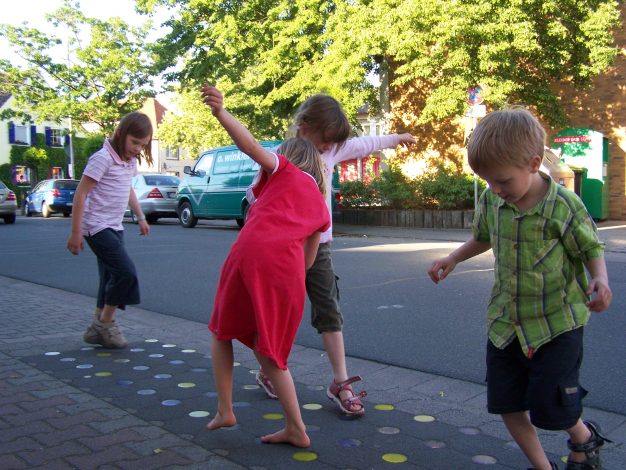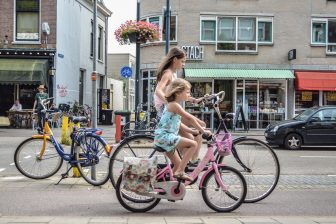
How a small town in Germany became a model for the ‘Playable City’.
The concept of the ‘playable city’ is essentially a simple one: join up the places that children want to access, with safe, attractive pathways animated with playful affordances – and design this network with the fullest engagement of the children who will use it. Here, Berta Kaufmann describes how a small town in Southern Germany developed the model that is becoming a template for child-friendly urban design.
In the modern world, children are increasingly scarce in public space. The places that are still accessible to them represent islands in the city; the space between these islands, mere transit routes. Even when allowed out of the car, traversing these paths on foot is a mostly monotonous, constrained experience, with houses on one side and cars on the other effectively creating a series of walled-in journies over featureless, monolithic pavements.
This observation was the starting point for the development of the ‘playable city’ concept. The playable city is an attempt to reclaim urban public space for children by better supporting their independent mobility at the the same time as making spaces more playfully attractive to them. Thus, important destinations within the child’s domain, such as schools and playgrounds, are linked to one another, and to where they live, through a network of safe and acessible pathways, which are additionally enhanced by play features: equipment, objects and installations of various design and function. The concept was exemplified by the town of Griesheim in Hessen Germany (www.griesheim.de), where two people in particular played a decisive role in its development.
Making play integral to urban design
Norbert Leber was the Mayor of Griesheim who had been involved in the city’s urban development since his entry into office in 1987. One of his innovations was to regularly host visits to the town hall by 3rd and 4th grade schoolchildren for guided walking tours tours of the municipal buildings and historical city centre. Equally important to the playable city concept in Griesheim was Professor Bernhard Meyer, from the University for Applied Sciences in Darmstadt. Professor Meyer has been working with children’s playgrounds since the 1980s and is particularly committed to their integral role within sustainable urban development.
The starting point for the concept was a practice research project with the aim of recapturing public space for children. This ambition was felt by the research team to be considerably more achievable in Griesheim because of the support of the mayor, his administration and the city’s school management. Through the Mayor’s hosted walking tours, the project was able to develop a regular means to consult with the town’s young population. The tours grew into more formal interviews with the visiting children, and their active participation in planning sessions.
our children can now play their way through their own city
– Professor Bernhard Meyer
Schoolchildren were given chalkboards to mark their way to school and were also asked to complete questionnaires about their journeys. In this way it became clear not only which places were important for to them, such as the sports field or the open market, but also how they got there. Thus, the most effective, child-friendly pedestrian schemes possible were evolved. One researcher remarked: “It was surprising, because there were more than a hundred possibilities.”
“Play street time”
After the project team – in close collaboration with the municipality’s real estate office – carefully examined the results, 101 different routes were identified, with each one receiving its own unique surface. There remained the task of commissioning or designing 101 playable features, one for each route. Here, the criteria for slection was not only that the installation be playful, but that it be versatile, ambiguous even, in its function, affording a variety of playful interactions – climbing, bouncing, sitting and more – for different children. Over the course of development of the Griesheim playable city, 25 new, sustainable playgrounds have been built, and the overall concept is further complemented by an initiative known as “play street time”. Here, different roads in Griesheimer become (for an afternoon per week or per month) a living street, free of cars, safe and accessible to children.
In a survey of 850 primary school children 75 per cent of them rated the project a positive improvement to the town. Professor Meyer concludes: “through this initiative, Griesheim has not only become more child-friendly, but our children can now play their way through their own city.”
Berta Kaufmann
Source: http://bespielbare-stadt.efhd.de
Photo: Bespielbare Stadt




